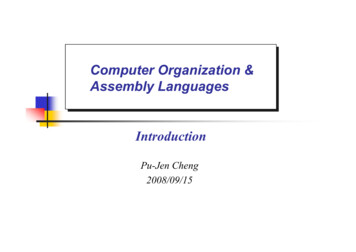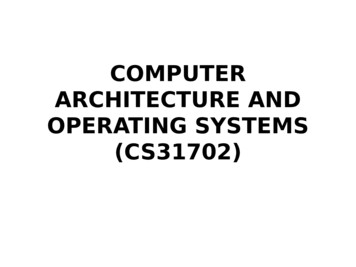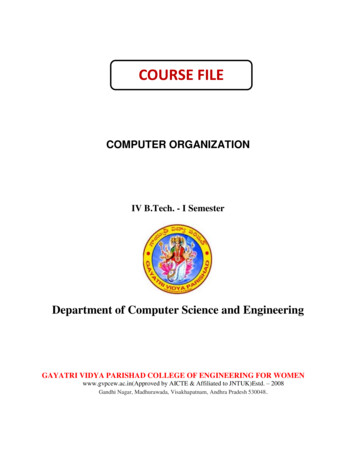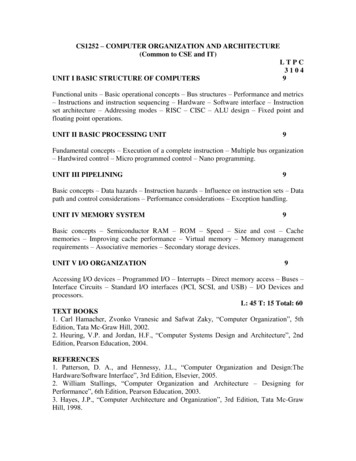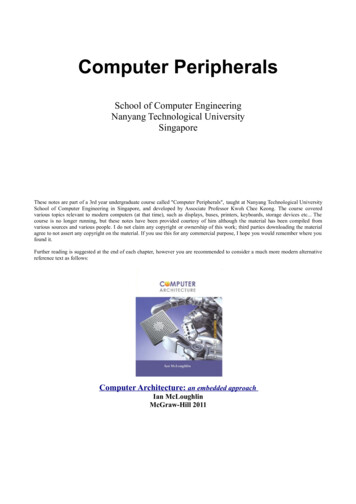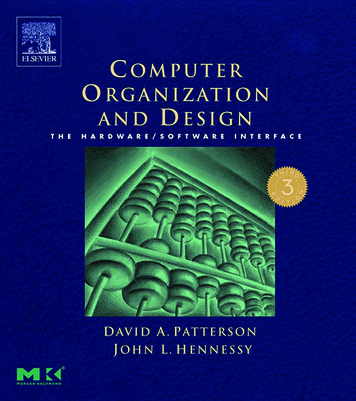
Transcription
THIRDEDITIONComputer Organization DesignT H EH A R D W A R E / S O F T W A R EI N T E R F A C E
A C K N O W L E D G E M E N T SFigures 1.9, 1.15 Courtesy of Intel.Computers in the Real World:Figure 1.11 Courtesy of Storage Technology Corp.Photo of “A Laotian villager,” courtesy of David Sanger.Figures 1.7.1, 1.7.2, 6.13.2 Courtesy of the Charles Babbage Institute,University of Minnesota Libraries, Minneapolis.Photo of an “Indian villager,” property of Encore Software, Ltd., India.Figures 1.7.3, 6.13.1, 6.13.3, 7.9.3, 8.11.2 Courtesy of IBM.Figure 1.7.4 Courtesy of Cray Inc.Figure 1.7.5 Courtesy of Apple Computer, Inc.Photos of “Block and students” and “a pop-up archival satellite tag,”courtesy of Professor Barbara Block. Photos by Scott Taylor.Photos of “Professor Dawson and student” and “the Mica micromote,”courtesy of AP/World Wide Photos.Figure 7.33 Courtesy of AMD.Photos of “images of pottery fragments” and “a computer reconstruction,” courtesy of Andrew Willis and David B. Cooper, Brown University,Division of Engineering.Figures 7.9.1, 7.9.2 Courtesy of Museum of Science, Boston.Photo of “the Eurostar TGV train,” by Jos van der Kolk.Figure 7.9.4 Courtesy of MIPS Technologies, Inc.Photo of “the interior of a Eurostar TGV cab,” by Andy Veitch.Figure 8.3 Peg Skorpinski.Photo of “firefighter Ken Whitten,” courtesy of World Economic Forum.Figure 8.11.1 Courtesy of the Computer Museum of America.Graphic of an “artificial retina,” The San Francisco Chronicle.Reprinted by permission.Figure 1.7.6 Courtesy of the Computer History Museum.Figure 8.11.3 Courtesy of the Commercial Computing Museum.Figures 9.11.2, 9.11.3 Courtesy of NASA Ames Research Center.Figure 9.11.4 Courtesy of Lawrence Livermore National Laboratory.Image of “A laser scan of Michelangelo’s statue of David,” courtesy ofMarc Levoy and Dr. Franca Falletti, director of the Galleria dell'Accademia, Italy.“An image from the Sistine Chapel,” courtesy of Luca Pezzati. IR imagerecorded using the scanner for IR reflectography of the INOA (NationalInstitute for Applied Optics, http://arte.ino.it) at the Opificio delle PietreDure in Florence.
THIRDEDITIONComputer Organization and DesignT H EH A R D W A R E / S O F T W A R EI N T E R F A C EDavid A. PattersonUniversity of California, BerkeleyJohn L. HennessyStanford UniversityWith a contribution byPeter J. AshendenAshenden Designs Pty LtdJames R. LarusMicrosoft ResearchAMSTERDAM BOSTON HEIDELBERG LONDONNEW YORK OXFORD PARIS SAN DIEGOSAN FRANCISCO SINGAPORE SYDNEY TOKYOMorgan Kaufmann is an imprint of ElsevierDaniel J. SorinDuke University
Senior EditorPublishing Services ManagerEditorial AssistantCover DesignCover and Chapter IllustrationText DesignCompositionTechnical IllustrationCopyeditorProofreaderIndexerInterior printerCover printerDenise E. M. PenroseSimon CrumpSummer BlockRoss Caron DesignChris AsimoudisGGS Book ServicesNancy Logan and Dartmouth Publishing, Inc.Dartmouth Publishing, Inc.Ken DellaPentaJacqui BrownsteinLinda BuskusCourierCourierMorgan Kaufmann Publishers is an imprint of Elsevier.500 Sansome Street, Suite 400, San Francisco, CA 94111This book is printed on acid-free paper. 2005 by Elsevier Inc. All rights reserved.Designations used by companies to distinguish their products are often claimed as trademarks or registeredtrademarks. In all instances in which Morgan Kaufmann Publishers is aware of a claim, the product namesappear in initial capital or all capital letters. Readers, however, should contact the appropriate companiesfor more complete information regarding trademarks and registration.No part of this publication may be reproduced, stored in a retrieval system, or transmitted in any form orby any means—electronic, mechanical, photocopying, scanning, or otherwise—without prior written permission of the publisher.Permissions may be sought directly from Elsevier’s Science & Technology Rights Department in Oxford,UK: phone: ( 44) 1865 843830, fax: ( 44) 1865 853333, e-mail: permissions@elsevier.com.uk. You mayalso complete your request on-line via the Elsevier homepage (http://elsevier.com) by selecting “CustomerSupport” and then “Obtaining Permissions.”Library of Congress Cataloging-in-Publication DataApplication submittedISBN: 1-55860-604-1For information on all Morgan Kaufmann publications,visit our Web site at www.mkp.com.Printed in the United States of America04 05 06 07 085 4 3 2 1
vContentsContentsPrefaceixC H A P T E R S1Computer Abstractions and Technology1.11.21.31.41.51.61.71.82Introduction 3Below Your Program 11Under the Covers 15Real Stuff: Manufacturing Pentium 4 Chips 28Fallacies and Pitfalls 33Concluding Remarks 35Historical Perspective and Further Reading 36Exercises 36C O M P U T E R S I N T H E R E A L W O R L DInformation Technology for the 4 Billion without IT 442Instructions: Language of the ntroduction 48Operations of the Computer Hardware 49Operands of the Computer Hardware 52Representing Instructions in the Computer 60Logical Operations 68Instructions for Making Decisions 72Supporting Procedures in Computer Hardware 79Communicating with People 90MIPS Addressing for 32-Bit Immediates and AddressesTranslating and Starting a Program 106How Compilers Optimize 116How Compilers Work: An Introduction 12195
viContents2.132.142.152.162.172.182.192.20A C Sort Example to Put It All Together 121Implementing an Object-Oriented Language 130Arrays versus Pointers 130Real Stuff: IA-32 Instructions 134Fallacies and Pitfalls 143Concluding Remarks 145Historical Perspective and Further Reading 147Exercises 147C O M P U T E R S I N T H E R E A LHelping Save Our Environment with Data 1563Arithmetic for roduction 160Signed and Unsigned Numbers 160Addition and Subtraction 170Multiplication 176Division 183Floating Point 189Real Stuff: Floating Point in the IA-32 217Fallacies and Pitfalls 220Concluding Remarks 225Historical Perspective and Further Reading 229Exercises 229C O M P U T E R S I N T H E R E A LReconstructing the Ancient World 2364W O R L DW O R L DAssessing and Understanding Performance4.14.24.34.44.54.64.74.8238Introduction 240CPU Performance and Its Factors 246Evaluating Performance 254Real Stuff: Two SPEC Benchmarks and the Performance of RecentIntel Processors 259Fallacies and Pitfalls 266Concluding Remarks 270Historical Perspective and Further Reading 272Exercises 272C O M P U T E R S I N T H E R E A LMoving People Faster and More Safely 280W O R L D
viiContents5The Processor: Datapath and Introduction 284Logic Design Conventions 289Building a Datapath 292A Simple Implementation Scheme 300A Multicycle Implementation 318Exceptions 340Microprogramming: Simplifying Control Design 346An Introduction to Digital Design Using a Hardware DesignLanguage 346Real Stuff: The Organization of Recent PentiumImplementations 347Fallacies and Pitfalls 350Concluding Remarks 352Historical Perspective and Further Reading 353Exercises 354C O M P U T E R S I N T H EEmpowering the Disabled 3666282R E A LW O R L DEnhancing Performance with .136.14368An Overview of Pipelining 370A Pipelined Datapath 384Pipelined Control 399Data Hazards and Forwarding 402Data Hazards and Stalls 413Branch Hazards 416Using a Hardware Description Language to Describe and Model aPipeline 426Exceptions 427Advanced Pipelining: Extracting More Performance 432Real Stuff: The Pentium 4 Pipeline 448Fallacies and Pitfalls 451Concluding Remarks 452Historical Perspective and Further Reading 454Exercises 454C O M P U T E R S I N T H E R E A L W O R L DMass Communication without Gatekeepers 464
viiiContents7Large and Fast: Exploiting Memory Hierarchy4667.17.27.37.47.57.6Introduction 468The Basics of Caches 473Measuring and Improving Cache Performance 492Virtual Memory 511A Common Framework for Memory Hierarchies 538Real Stuff: The Pentium P4 and the AMD Opteron MemoryHierarchies 5467.7 Fallacies and Pitfalls 5507.8 Concluding Remarks 5527.9 Historical Perspective and Further Reading 5557.10 Exercises 555C O M P U T E R S I N T H E R E A LSaving the World's Art Treasures 5628W O R L DStorage, Networks, and Other Peripherals8.18.28.38.4564Introduction 566Disk Storage and Dependability 569Networks 580Buses and Other Connections between Processors, Memory, and I/ODevices 5818.5 Interfacing I/O Devices to the Processor, Memory, and OperatingSystem 5888.6 I/O Performance Measures: Examples from Disk and FileSystems 5978.7 Designing an I/O System 6008.8 Real Stuff: A Digital Camera 6038.9 Fallacies and Pitfalls 6068.10 Concluding Remarks 6098.11 Historical Perspective and Further Reading 6118.12 Exercises 611C O M P U T E R S I N T H E R E A LSaving Lives through Better Diagnosis 6229Multiprocessors and Clusters9.19.29.3W O R L D9-2Introduction 9-4Programming Multiprocessors 9-8Multiprocessors Connected by a Single Bus9-11
ssors Connected by a Network 9-20Clusters 9-25Network Topologies 9-27Multiprocessors Inside a Chip and MultithreadingReal Stuff: The Google Cluster of PCs 9-34Fallacies and Pitfalls 9-39Concluding Remarks 9-42Historical Perspective and Further Reading 9-47Exercises 9-559-30A P P E N D I C E SAAssemblers, Linkers, and the SPIM ntroduction A-3Assemblers A-10Linkers A-18Loading A-19Memory Usage A-20Procedure Call Convention A-22Exceptions and Interrupts A-33Input and Output A-38SPIM A-40MIPS R2000 Assembly Language A-45Concluding Remarks A-81Exercises A-82The Basics of Logic uction B-3Gates, Truth Tables, and Logic Equations B-4Combinational Logic B-8Using a Hardware Description Language B-20Constructing a Basic Arithmetic Logic Unit B-26Faster Addition: Carry Lookahead B-38Clocks B-47Memory Elements: Flip-flops, Latches, and RegistersMemory Elements: SRAMs and DRAMs B-57Finite State Machines B-67Timing Methodologies B-72B-49A-2
xContentsB.12 Field Programmable DevicesB.13 Concluding Remarks B-78B.14 Exercises B-79CMapping Control to HardwareC.1C.2C.3C.4C.5C.6C.7DB-77C-2Introduction C-3Implementing Combinational Control Units C-4Implementing Finite State Machine Control C-8Implementing the Next-State Function with a SequencerTranslating a Microprogram to Hardware C-27Concluding Remarks C-31Exercises C-32C-21A Survey of RISC Architectures for Desktop, Server,and Embedded Computers D.15D.16D.17D.18D.19Introduction D-3Addressing Modes and Instruction Formats D-5Instructions: The MIPS Core Subset D-9Instructions: Multimedia Extensions of the Desktop/Server RISCsInstructions: Digital Signal-Processing Extensions of theEmbedded RISCs D-19Instructions: Common Extensions to MIPS Core D-20Instructions Unique to MIPS64 D-25Instructions Unique to Alpha D-27Instructions Unique to SPARC v.9 D-29Instructions Unique to PowerPC D-32Instructions Unique to PA-RISC 2.0 D-34Instructions Unique to ARM D-36Instructions Unique to Thumb D-38Instructions Unique to SuperH D-39Instructions Unique to M32R D-40Instructions Unique to MIPS16 D-41Concluding Remarks D-43Acknowledgments D-46References D-47EIndex I-1Glossary G-1Further ReadingFR-1D-16
xiPrefacePrefaceThe most beautiful thing we can experience is the mysterious.It is the source of all true art and science.Albert Einstein, What I Believe, 1930About This BookWe believe that learning in computer science and engineering should reflect thecurrent state of the field, as well as introduce the principles that are shaping computing. We also feel that readers in every specialty of computing need to appreciate the organizational paradigms that determine the capabilities, performance,and, ultimately, the success of computer systems.Modern computer technology requires professionals of every computing specialty to understand both hardware and software. The interaction between hardware and software at a variety of levels also offers a framework for understandingthe fundamentals of computing. Whether your primary interest is hardware orsoftware, computer science or electrical engineering, the central ideas in computerorganization and design are the same. Thus, our emphasis in this book is to showthe relationship between hardware and software and to focus on the concepts thatare the basis for current computers.The audience for this book includes those with little experience in assemblylanguage or logic design who need to understand basic computer organization aswell as readers with backgrounds in assembly language and/or logic design whowant to learn how to design a computer or understand how a system works andwhy it performs as it does.About the Other BookSome readers may be familiar with Computer Architecture: A QuantitativeApproach, popularly known as Hennessy and Patterson. (This book in turn iscalled Patterson and Hennessy.) Our motivation in writing that book was todescribe the principles of computer architecture using solid engineering funda-
anceBlankmentalsquantitativetrade-offs. We used an approach thatcombined examples and measurements, based on commercial systems, to createrealistic design experiences. Our goal was to demonstrate that computer architecture could be learned using quantitative methodologies instead of a descriptiveapproach. It is intended for the serious computing professional who wants adetailed understanding of computers.A majority of the readers for this book do not plan to become computer architects. The performance of future software systems will be dramatically affected,however, by how well software designers understand the basic hardware techniques at work in a system. Thus, compiler writers, operating system designers,database programmers, and most other software engineers need a firm groundingin the principles presented in this book. Similarly, hardware designers mustunderstand clearly the effects of their work on software applications.Thus, we knew that this book had to be much more than a subset of the material in Computer Architecture, and the material was extensively revised to matchthe different audience. We were so happy with the result that the subsequent editions of Computer Architecture were revised to remove most of the introductorymaterial; hence, there is much less overlap today than with the first editions ofboth books.Changes for the Third EditionWe had six major goals for the third edition of Computer Organization and Design:make the book work equally well for readers with a software focus or with a hardware focus; improve pedagogy in general; enhance understanding of program performance; update the technical content to reflect changes in the industry since thepublication of the second edition in 1998; tie the ideas from the book more closelyto the real world outside the computing industry; and reduce the size of this book.First, the table on the next page shows the hardware and software paths throughthe material. Chapters 1, 4, and 7 are found on both paths, no matter what the experience or the focus. Chapters 2 and 3 are likely to be review material for the hardware-oriented, but are essential reading for the software-oriented, especially forthose readers interested in learning more about compilers and object-oriented programming languages. The first sections of Chapters 5 and 6 give overviews for thosewith a software focus. Those with a hardware focus, however, will find that thesechapters present core material; they may also, depending on background, want toread Appendix B on logic design first and the sections on microprogramming andhow to use hardware description languages to specify control. Chapter 8 oninput/output is key to readers with a software focus and should be read if time permits by others. The last chapter on multiprocessors and clusters is again a questionof time for the reader. Even the history sections show this balanced focus; theyinclude short histories of programming languages, compilers, numerical software,operating systems, networking protocols, and databases.
xiiiPrefaceChapter or AppendixSectionsSoftware Focus Hardware Focus1.1 to 1.61. Computer Abstractionsand Technology1.7 (History)2.1 to 2.112.12 (Compilers)2.13 (C sort)2. Instructions: Languageof the Computer2.14 (Java)2.15 to 2.182.19 (History)3.1 to 3.113. Arithmetic for Computers3.12 (History)D. RISC instruction set architectures4. Assessing and UnderstandingPerformanceB. The Basics of Logic DesignD.1 to D.194.1 to 4.64.7 (History)B.1 to B.135.1 (Overview)5.2 to 5.75. The Processor: Datapath andControl5.8 (Microcode)5.9 (Verilog)5.10 to 5.125.13 (History)C. Mapping Control to HardwareC.1 to C.66.1 (Overview)6.2 to 6.66. Enhancing Performance withPipelining6.7 (verilog)6.8 to 6.96.10 to 6.126.13 (History)7. Large and Fast: ExploitingMemory Hierarchy7.1 to 7.87.9 (History)8.1 to 8.28. Storage, Networks, andOther Peripherals8.3 (Networks)8.4 to 8.108.13 (History)9. Multiprocessors and ClustersA. Assemblers, Linkers, andthe SPIM SimulatorComputers in the Real World9.1 to 9.109.11 (History)A.1 to A.12Between ChaptersRead carefullyRead if have timeReview or readRead for cultureReference
xivPrefaceThe next goal was to improve the exposition of the ideas in the book, based ondifficulties mentioned by readers of the second edition. We added five new bookelements to help. To make the book work better as a reference, we placed definitions of new terms in the margins at their first occurrence. We hope this will helpreaders find the sections when they want to refer back to material they havealready read. Another change was the insertion of the “Check Yourself ” sections,which we added to help readers to check their comprehension of the material onthe first time through it. A third change is that added extra exercises in the “ForMore Practice” section. Fourth, we added the answers to the “Check Yourself ” sections and to the For More Practice exercises to help readers see for themselves ifthey understand the material by comparing their answers to the book. The finalnew book element was inspired by the "Green Card" of the IBM System/360. Webelieve that you will find that the MIPS Reference Data Card will be a handy reference when writing MIPS assembly language programs. Our idea is that you willremove the card from the front of the book, fold it in half, and keep it in yourpocket, just as IBM S/360 programmers did in the 1960s.Third, computers are so complex today that understanding the performance ofa program involves understanding a good deal about the underlying principlesand the organization of a given computer. Our goal is that readers of this bookshould be able to understand the performance of their progams and how toimprove it. To aid in that goal, we added a new book element called “Understanding Program Performance” in several chapters. These sections often give concreteexamples of how ideas in the chapter affect performance of real programs.Fourth, in the interval since the second edition of this book, Moore’s law hasmarched onward so that we now have processors with 200 million transistors,DRAM chips with a billion transistors, and clock rates of multiple gigahertz. The“Real Stuff ” examples have been updated to describe such chips. This edition alsoincludes AMD64/IA-32e, the 64-bit address version of the long-lived 80x86 architecture, which appears to be the nemesis of the more recent IA-64. It also reflectsthe transition from parallel buses to serial networks and switches. Later chaptersdescribe Google, which was born after the second edition, in terms of its clustertechnology and in novel uses of search.Fifth, although many computer science and engineering students enjoy information technology for technology’s sake, some have more altruistic interests. Thislatter group tends to have more women and underrepresented minorities. Consequently, we have added a new book element, “Computers in the Real World,” twopage layouts found between each chapter. Our perspective is that informationtechnology is more valuable for humanity than most other topics you couldstudy—whether it is preserving our art heritage, helping the Third World, savingour environment, or even changing political systems—and so we demonstrate ourview with concrete examples of nontraditional applications. We think readers ofthese segments will have a greater appreciation of the computing culture beyond
xvPrefacethe inherently interesting technology, much like those who read the history sections at the end of each chapterFinally, books are like people: they usually get larger as they get older. By usingtechnology, we have managed to do all the above and yet shrink the page count byhundreds of pages. As the table illustrates, the core portion of the book for hardware and software readers is on paper, but sections that some readers would valuemore than others are found on the companion CD. This technology also allowsyour authors to provide longer histories and more extensive exercises withoutconcerns about lengthening the book. Once we added the CD to the book, wecould then include a great deal of free software and tutorials that many instructorshave told us they would like to use in their courses. This hybrid paper-CD publication weighs about 30% less than it did six years ago—an impressive goal forbooks as well as for people.Instructor SupportWe have collected a great deal of material to help instructors teach courses usingthis book. Solutions to exercises, figures from the book, lecture notes, lectureslides, and other materials are available to adopters from the publisher. Check thepublisher’s Web site for more uding RemarksIf you read the following acknowledgments section, you will see that we went togreat lengths to correct mistakes. Since a book goes through many printings, wehave the opportunity to make even more corrections. If you uncover any remaining,resilient bugs, please contact the publisher by electronic mail at cod3bugs@mkp.comor by low-tech mail using the address found on the copyright page. The first personto report a technical error will be awarded a 1.00 bounty upon its implementationin future printings of the book!This book is truly collaborative, despite one of us running a major university.Together we brainstormed about the ideas and method of presentation, then individually wrote about one-half of the chapters and acted as reviewer for every draftof the other half. The page count suggests we again wrote almost exactly the samenumber of pages. Thus, we equally share the blame for what you are about to read.Acknowledgments for the Third EditionWe’d like to again express our appreciation to Jim Larus for his willingness in contributing his expertise on assembly language programming, as well as for welcoming readers of this book to use the simulator he developed and maintains. Our
xviPrefaceexercise editor Dan Sorin took on the Herculean task of adding new exercises andanswers. Peter Ashenden worked similarly hard to collect and organize the companion CD.We are grateful to the many instructors who answered the publisher’s surveys,reviewed our proposals, and attended focus groups to analyze and respond to ourplans for this edition. They include the following individuals: Michael Anderson(University of Hartford), David Bader (University of New Mexico), Rusty Baldwin(Air Force Institute of Technology), John Barr (Ithaca College), Jack Briner(Charleston Southern University), Mats Brorsson (KTH, Sweden), Colin Brown(Franklin University), Lori Carter (Point Loma Nazarene University), John Casey(Northeastern University), Gene Chase (Messiah College), George Cheney (University of Massachusetts, Lowell), Daniel Citron (Jerusalem College of Technology,Israel), Albert Cohen (INRIA, France), Lloyd Dickman (PathScale), Jose Duato(Universidad Politécnica de Valencia, Spain), Ben Dugan (University of Washington), Derek Eager (University of Saskatchewan, Canada), Magnus Ekman (Chalmers University of Technology, Sweden), Ata Elahi (Southern Connecticut StateUniversity), Soundararajan Ezekiel (Indiana University of Pennsylvania), ErnestFerguson (Northwest Missouri State University), Michael Fry (Lebanon Valley College, Pennsylvania), R. Gaede (University of Arkansas at Little Rock), Jean-LucGaudiot (University of California, Irvine), Thomas Gendreau (University of Wisconsin, La Crosse), George Georgiou (California State University, San Bernardino),Paul Gillard (Memorial University of Newfoundland, Canada), Joe Grimes (California Polytechnic State University, SLO), Max Hailperin (Gustavus Adolphus College), Jayantha Herath (St. Cloud State University, Minnesota), Mark Hill(University of Wisconsin, Madison), Michael Hsaio (Virginia Tech), RichardHughey (University of California, Santa Cruz), Tony Jebara (Columbia University),Elizabeth Johnson (Xavier University), Peter Kogge (University of Notre Dame),Morris Lancaster (BAH), Doug Lawrence (University of Montana), David Lilja(University of Minnesota), Nam Ling (Santa Clara University, California), Paul Lum(Agilent Technologies), Stephen Mann (University of Waterloo, Canada), DianaMarculescu (Carnegie Mellon University), Margaret McMahon (U.S. Naval Academy Computer Science), Uwe Meyer-Baese (Florida State University), Chris Milner(University of Virginia), Tom Pittman (Southwest Baptist University), Jalel Rejeb(San Jose State University, California), Bill Siever (University of Missouri, Rolla),Kevin Skadron (University of Virginia), Pam Smallwood (Regis University, Colorado), K. Stuart Smith (Rocky Mountain College), William J. Taffe (Plymouth StateUniversity), Michael E. Thomodakis (Texas A&M University), Ruppa K. Thulasiram(University of Manitoba, Canada), Ye Tung (University of South Alabama), SteveVanderLeest (Calvin College), Neal R. Wagner (University of Texas at San Antonio),and Kent Wilken (University of California, Davis).
xviiPrefaceWe are grateful too to those who carefully read our draft manuscripts; someread successive drafts to help ensure new errors didn’t creep in as we revised.They include Krste Asanovic (Massachusetts Institute of Technology), Jean-LoupBaer (University of Washington), David Brooks (Harvard University), Doug Clark(Princeton University), Dan Connors (University of Colorado at Boulder), MattFarrens (University of California, Davis), Manoj Franklin (University of MarylandCollege Park), John Greiner (Rice University), David Harris (Harvey Mudd College), Paul Hilfinger (University of California, Berkeley), Norm Jouppi (HewlettPackard), David Kaeli (Northeastern University), David Oppenheimer (Universityof California, Berkeley), Timothy Pinkston (University of Southern California),Mark Smotherman (Clemson University), and David Wood (University of Wisconsin, Madison).To help us meet our goal of creating 70% new exercises and solutions for thisedition, we recruited several graduate students recommended to us by their professors. We are grateful for their creativity and persistence: Michael Black (University of Maryland), Lei Chen (University of Rochester), Nirav Dave(Massachusetts Institute of Technology), Wael El Essawy (University of Rochester), Nikil Mehta (Brown University), Nicholas Nelson (University of Rochester),Aaron Smith (University of Texas, Austin), and Charlie Wang (Duke University).We would like to especially thank Mark Smotherman for making a careful finalpass to find technical and writing glitches that significantly improved the qualityof this edition.We wish to thank the extended Morgan Kaufmann family for agreeing to publish this book again under the able leadership of Denise Penrose. She developedthe vision of the hybrid paper-CD book and recruited the many people above whoplayed important roles in developing the book.Simon Crump managed the book production process, and Summer Blockcoordinated the surveying of users and their responses. We thank also the manyfreelance vendors who contributed to this volume, especially Nancy Logan andDartmouth Publishing, Inc., our compositors.The contributions of the nearly 100 people we mentioned here have made thisthird edition our best book yet. Enjoy!David A. PattersonJohn L. Hennessy
This Page Intentionally Left Blank
1ComputerAbstractionsand TechnologyCivilization advances by extendingthe number of important operationswhich we can perform withoutthinking about them.Alfred North WhiteheadAn Introduction to Mathematics, 1911
This Page Intentionally Left Blank
1.11.1Introduction 31.2Below Your Program 111.3Under the Covers 151.4Real Stuff: Manufacturing Pentium 4 Chips 281.5Fallacies and Pitfalls 331.6Concluding Remarks 351.7Historical Perspective and Further Reading 361.8Exercises 36Introduction1.1Welcome to this book! We’re delighted to have this opportunity to convey theexcitement of the world of computer systems. This is not a dry and dreary field,where progress is glacial and where new ideas atrophy from neglect. No! Computers are the product of the incredibly vibrant information technology industry, allaspects of which are responsible for almost 10% of the gross national product ofthe United States. This unusual industry embraces innovation at a breathtakingrate. Since 1985 there have been a number of new computers whose introductionappeared to revolutionize the computing industry; these revolutions were cutshort only because someone else built an even better computer.This race to innovate has led to unprecedented progress since the inception ofelectronic computing in the late 1940s. Had the transportation industry kept pacewith the computer industry, for example, today we could travel coast to coast inabout a second for roughly a few cents. Take just a moment to contemplate howsuch an improvemen
5.2 Logic Design Conventions 289 5.3 Building a Datapath 292 5.4 A Simple Implementation Scheme 300 5.5 A Multicycle Implementation 318 5.6 Exceptions 340 5.7 Microprogramming: Simplifying Control Design 346 5.8 An Introduction to Digital Design Using a Hardware Design Language 346 5.9 Real Stuff: The Organization of Recent Pentium .


